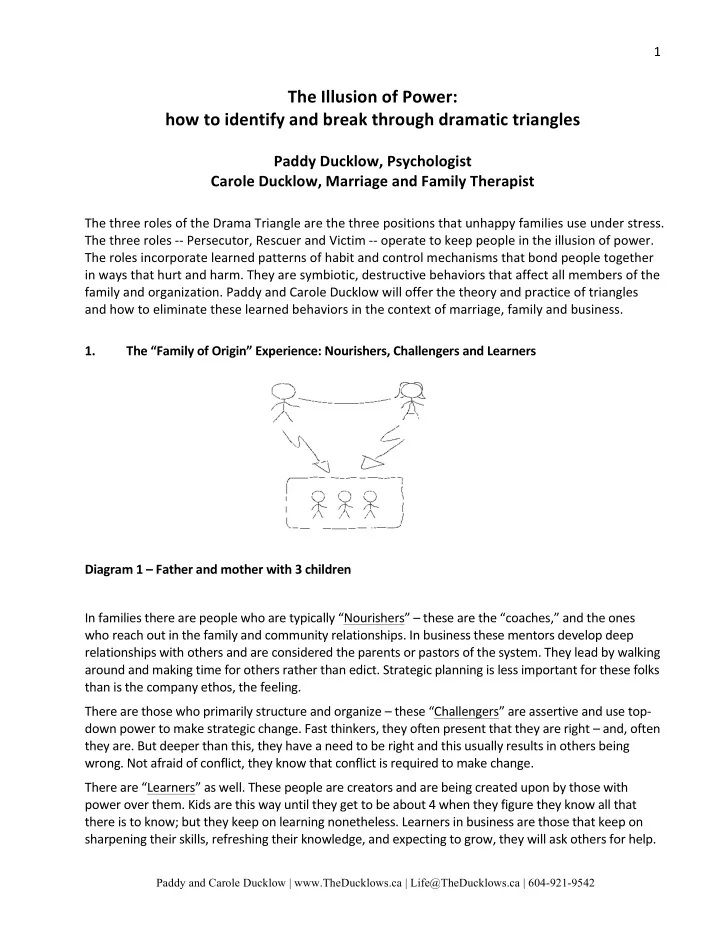

1 ¡ The ¡Illusion ¡of ¡Power: ¡ how ¡to ¡identify ¡and ¡break ¡through ¡dramatic ¡triangles ¡ ¡ Paddy ¡Ducklow, ¡Psychologist ¡ Carole ¡Ducklow, ¡Marriage ¡and ¡Family ¡Therapist ¡ ¡ The ¡three ¡roles ¡of ¡the ¡Drama ¡Triangle ¡are ¡the ¡three ¡positions ¡that ¡unhappy ¡families ¡use ¡under ¡stress. ¡ The ¡three ¡roles ¡-‑-‑ ¡Persecutor, ¡Rescuer ¡and ¡Victim ¡-‑-‑ ¡operate ¡to ¡keep ¡people ¡in ¡the ¡illusion ¡of ¡power. ¡ The ¡roles ¡incorporate ¡learned ¡patterns ¡of ¡habit ¡and ¡control ¡mechanisms ¡that ¡bond ¡people ¡together ¡ in ¡ways ¡that ¡hurt ¡and ¡harm. ¡They ¡are ¡symbiotic, ¡destructive ¡behaviors ¡that ¡affect ¡all ¡members ¡of ¡the ¡ family ¡and ¡organization. ¡Paddy ¡and ¡Carole ¡Ducklow ¡will ¡offer ¡the ¡theory ¡and ¡practice ¡of ¡triangles ¡ and ¡how ¡to ¡eliminate ¡these ¡learned ¡behaviors ¡in ¡the ¡context ¡of ¡marriage, ¡family ¡and ¡business. ¡ ¡ 1. The ¡“Family ¡of ¡Origin” ¡Experience: ¡Nourishers, ¡Challengers ¡and ¡Learners ¡ ¡ ¡ ¡ ¡ ¡ ¡ ¡ ¡ Diagram ¡1 ¡– ¡Father ¡and ¡mother ¡with ¡3 ¡children ¡ ¡ In ¡families ¡there ¡are ¡people ¡who ¡are ¡typically ¡“Nourishers” ¡– ¡these ¡are ¡the ¡“coaches,” ¡and ¡the ¡ones ¡ who ¡reach ¡out ¡in ¡the ¡family ¡and ¡community ¡relationships. ¡In ¡business ¡these ¡mentors ¡develop ¡deep ¡ relationships ¡with ¡others ¡and ¡are ¡considered ¡the ¡parents ¡or ¡pastors ¡of ¡the ¡system. ¡They ¡lead ¡by ¡walking ¡ around ¡and ¡making ¡time ¡for ¡others ¡rather ¡than ¡edict. ¡Strategic ¡planning ¡is ¡less ¡important ¡for ¡these ¡folks ¡ than ¡is ¡the ¡company ¡ethos, ¡the ¡feeling. ¡ There ¡are ¡those ¡who ¡primarily ¡structure ¡and ¡organize ¡– ¡these ¡“Challengers” ¡are ¡assertive ¡and ¡use ¡top-‑ down ¡power ¡to ¡make ¡strategic ¡change. ¡Fast ¡thinkers, ¡they ¡often ¡present ¡that ¡they ¡are ¡right ¡– ¡and, ¡often ¡ they ¡are. ¡But ¡deeper ¡than ¡this, ¡they ¡have ¡a ¡need ¡to ¡be ¡right ¡and ¡this ¡usually ¡results ¡in ¡others ¡being ¡ wrong. ¡Not ¡afraid ¡of ¡conflict, ¡they ¡know ¡that ¡conflict ¡is ¡required ¡to ¡make ¡change. ¡ There ¡are ¡“Learners” ¡as ¡well. ¡These ¡people ¡are ¡creators ¡and ¡are ¡being ¡created ¡upon ¡by ¡those ¡with ¡ power ¡over ¡them. ¡Kids ¡are ¡this ¡way ¡until ¡they ¡get ¡to ¡be ¡about ¡4 ¡when ¡they ¡figure ¡they ¡know ¡all ¡that ¡ there ¡is ¡to ¡know; ¡but ¡they ¡keep ¡on ¡learning ¡nonetheless. ¡Learners ¡in ¡business ¡are ¡those ¡that ¡keep ¡on ¡ sharpening ¡their ¡skills, ¡refreshing ¡their ¡knowledge, ¡and ¡expecting ¡to ¡grow, ¡they ¡will ¡ask ¡others ¡for ¡help. ¡ Paddy and Carole Ducklow | www.TheDucklows.ca | Life@TheDucklows.ca | 604-921-9542
2 ¡ In ¡families, ¡the ¡2-‑parent ¡leading ¡with ¡one ¡or ¡more ¡children ¡following ¡is ¡considered ¡a ¡healthy ¡triangle ¡ that ¡reciprocates ¡and ¡balances. ¡Submission ¡or ¡responsiveness ¡is ¡mostly ¡normal ¡and ¡natural ¡for ¡kids ¡– ¡ adults ¡tend ¡to ¡pride ¡up, ¡defend, ¡dismiss ¡and ¡define. ¡[ Take ¡a ¡minute ¡to ¡understand ¡your ¡recent ¡conflicts ¡ at ¡home ¡or ¡at ¡work. ¡Did ¡you ¡not ¡pride ¡up ¡with ¡intent ¡to ¡pummel ¡the ¡other? ] ¡Submission ¡is ¡the ¡capacity ¡ to ¡suspend ¡judgement ¡long ¡enough ¡such ¡that ¡new ¡learning ¡can ¡go ¡on ¡and ¡new ¡resources ¡can ¡be ¡ developed. ¡Submission ¡is ¡closely ¡related ¡to ¡humility ¡or ¡responsiveness. ¡It ¡is ¡the ¡opposite ¡of ¡the ¡ coercion ¡that ¡makes ¡one ¡collapse. ¡ ¡ 2. Seeking ¡Stability ¡ Triangles ¡are ¡the ¡basis ¡of ¡stable ¡relationships. ¡The ¡pyramid ¡is ¡the ¡strongest ¡and ¡most ¡enduring ¡shape ¡in ¡ design. ¡Triangles ¡in ¡relationship ¡are ¡similar. ¡Typically ¡two ¡parts ¡of ¡a ¡triangle ¡“collude” ¡at ¡the ¡expense ¡of ¡ another. ¡[ Two ¡elementary ¡school ¡girls ¡bind ¡their ¡relationship ¡by ¡not ¡liking ¡a ¡boy ¡and ¡a ¡triangle ¡is ¡ formed. ] ¡ ¡ Girl 1 ¡ collusion ¡ ¡ Isolated ¡3rd ¡ 2 ¡in ¡ ¡ Girl 2 ¡ Diagram ¡2 ¡– ¡Collusion ¡with ¡an ¡isolated ¡third ¡ ¡ The ¡family ¡is ¡the ¡most ¡primitive ¡triangle ¡and ¡the ¡most ¡enduring. ¡In ¡Canada ¡and ¡less ¡so ¡than ¡in ¡the ¡ United ¡States, ¡the ¡family ¡is ¡defined ¡by ¡an ¡unmarried ¡couple ¡with ¡no ¡intent ¡of ¡marrying, ¡and ¡one ¡or ¡ more ¡children ¡living ¡in ¡a ¡proximity ¡that ¡permits ¡both ¡parents ¡and ¡children ¡to ¡grow ¡through ¡challenge ¡ and ¡nourishment. ¡Not ¡exactly ¡the ¡definition ¡of ¡the ¡family ¡of ¡50 ¡years ¡ago ¡where ¡the ¡wedding ¡was ¡the ¡ starting ¡point ¡of ¡a ¡therapeutic ¡triangle. ¡ This ¡stability ¡in ¡a ¡family ¡or ¡system ¡is ¡both ¡positive ¡and ¡negative. ¡The ¡positive ¡is ¡that ¡the ¡security ¡of ¡the ¡ system ¡upholds ¡values ¡and ¡intimacy ¡to ¡the ¡betterment ¡of ¡all ¡involved. ¡But ¡to ¡mature ¡a ¡system ¡you ¡need ¡ instability ¡otherwise ¡growth ¡does ¡not ¡occur. ¡People ¡don’t ¡change ¡or ¡evolve ¡without ¡movement ¡and ¡ movement ¡requires ¡challenge. ¡Conflict ¡is ¡a ¡kind ¡of ¡challenge ¡for ¡change. ¡ Conflict ¡is ¡a ¡kind ¡of ¡energy. ¡You ¡don’t ¡manage ¡conflict ¡– ¡you ¡work ¡with ¡it. ¡We ¡find ¡conflict ¡ uncomfortable ¡or ¡upsetting ¡because ¡it ¡removes ¡comfort ¡and ¡results ¡in ¡unsettledness. ¡It ¡promotes ¡ anxiety ¡and ¡the ¡body ¡or ¡system ¡is ¡required ¡to ¡change. ¡ Triangles ¡work. ¡But ¡in ¡difficult ¡families ¡or ¡offices ¡or ¡extended ¡relationships, ¡triangles ¡cause ¡and ¡ maintain ¡more ¡problems ¡that ¡they ¡solve. ¡ Paddy and Carole Ducklow | www.TheDucklows.ca | Life@TheDucklows.ca | 604-921-9542
Recommend
More recommend